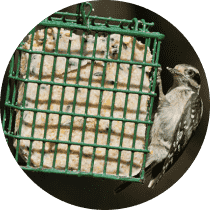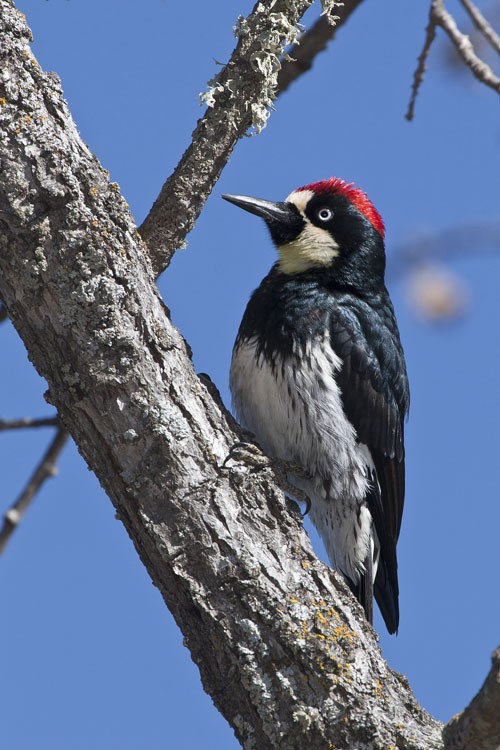Acorn Woodpecker
A species of Melanerpine Woodpeckers Scientific name : Melanerpes formicivorus Genus : Melanerpine Woodpeckers
Acorn Woodpecker, A species of Melanerpine Woodpeckers
Botanical name: Melanerpes formicivorus
Genus: Melanerpine Woodpeckers
Content
Description People often ask General Info
Description
The adult acorn woodpecker has a brownish-black head, back, wings and tail, white forehead, throat, belly and rump. The eyes are white. There is a small part on the small of their backs where there are some green feathers. The adult male has a red cap starting at the forehead, whereas females have a black area between the forehead and the cap. The white neck, throat, and forehead patches are distinctive identifiers. When flying, they take a few flaps of their wings and drop a foot or so. White circles on their wings are visible when in flight. Acorn woodpeckers have a call that sounds almost like they are laughing. Measurements: Length: 7.5-9.1 in (19-23 cm) Weight: 2.3-3.2 oz (65-90 g) Wingspan: 13.8-16.9 in (35-43 cm) 
Size
23 cm
Colors
Brown
Black
Gray
Life Expectancy
16 years
Nest Placement
Cavity
Clutch Size
3 - 6 eggs
Incubation Period
1 - 2 broods
Number of Broods
11 days
Nestling Period
30 - 32 days
Feeding Habits
Acorn Woodpecker consume a diverse diet, primarily acorns, also insects, fruit, sap, and occasionally lizards and eggs. They create granaries in trees, structures, storing and managing acorns with meticulous care to prevent desiccation and theft. Insectivory includes aerial sallying from perches. Acorn Woodpecker sometimes relocate for food resources.
Habitat
Acorn Woodpecker primarily inhabits oak and pine-oak woodlands throughout western Oregon, California, Mexico, and Central America down to Colombia. Preferring regions with abundant oaks, acorn Woodpecker also adapts to diverse environments such as streamside and coniferous forests, tropical hardwoods, and even urban areas with oak presence. Typical altitudes range from sea level to the upper limits of oak growth, although in Central America, they generally reside above 1,000 m (3,300 ft). Nesting occurs in dead trees or tree parts.
Nest Behavior
The timing for acorn Woodpecker nest building can begin at various times, often depending on the region. These birds exhibit cooperative breeding behaviors and do not construct a traditional nest, but rather lay their eggs atop accumulated wood chips. Egg-laying is communal, with multiple females contributing eggs to a single cavity. Both males and females share in incubating the eggs and feeding the young.
Nest Characteristics
Acorn Woodpecker typically create their nests by excavating cavities in dead or living tree limbs; these can be part of their granary tree or in other large trees. The cavities generally measure about 6 inches in diameter and can range from 8 inches to over 2 feet deep. Inside, a layer of fresh wood chips, a byproduct of the excavation, serves as the nest's base.
Dite type
Insectivorous
People often ask
General Info
Feeding Habits
Bird food type
Bird Feeder Type

Platform

Suet Cage
Sounds
Call
Recording location: United States
Call
Recording location: United States
Behavior
Acorn Woodpecker exhibit highly social and complex behavior within family groups that can exceed a dozen members, often working collaboratively in rearing young and managing food resources. Their days are spent foraging, and this species stands out for creating and fiercely defending extensive granaries in tree bark to store acorns, which are vital to their diet. These granaries also serve as central points for their 15-acre territorial range. Acorn Woodpecker's cooperative breeding poses a distinctive dynamic, with multiple breeding individuals in a group and a practice of shared nesting where egg destruction is common until laying periods synchronize. Additionally, non-breeding acorn Woodpeckers may travel up to 10 miles to find opportunities to breed in other groups, indicating a mix of sedentary and exploratory behaviors within the species.
Distribution Area
The acorn woodpecker's habitat is forested areas with oaks in the coastal areas and foothills of Oregon, California, and the southwestern United States, south through Central America to Colombia. This species may occur at low elevations in the north of its range, but rarely below 1,000 m (3,300 ft) in Central America, and it breeds up to the timberline. Nests are excavated in a large cavity in a dead tree or a dead part of a tree. 
Species Status
Not globally threatened.
Scientific Classification
Phylum
Chordates Class
Birds Family
Woodpeckers Genus
Melanerpine Woodpeckers Species
Acorn Woodpecker 